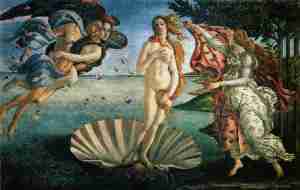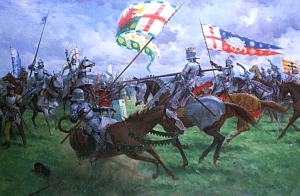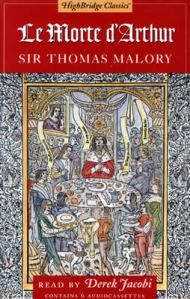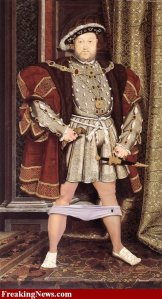Poets (dichters) such as Edmund Spencer and John Milton produced works that demonstrated an increased interest in understanding English Christian beliefs, such as the allegorical (zinnebeeldig) representation of the Tudor Dynasty (Regeerde als koning van Engeland en Wales en later ook Ierland) in The Faerie Queen and the retelling of mankink’s fall from paradise in Paradise Lost; playwrights (toneelschrijvers), such as Christopher Marlowe and William Shakespeare, composed theatrical representations of the English take on life, death, and history. Nearing the end of the Tudor dynasty, philosopher like Sir Thomas More and Sir Francis Bacon published their own ideas about humanity and the aspects of a perfect society, pushing the limits of metacognition (metacognitie) at that time. England came closer to reaching modern science with the Baconian Method, a forerunner of the Scientific Method.
Slow transition and mixture (langzame overgang/overtocht en vermenging)
The steadfast English mind clung to the old order of things, and relinquished with reluctance the last relics of a style that had been for centuries a part of its life. Thus all the Renaissance that came into England, after the bloody Wars of the Roses made it possible to think of art and luxury, paid toll to the Gothic on the way, and the result was a singular miscellany, for its Gothic had now forgotten, and its Renaissance had never known why it had existed. It is rather the talent with which the medley of material was handled, the broad masses, yet curious elaboration, and the scale of magnificence, that give the style its charm rather than anything in its original and bastard composition.
Something of this same charm is to be found in most of the literature of the era, in accordance with that subtle relationship existing between the literature and the art of any period. It is in the lawless mixture of Gothic and Grecian characterizing the Elizabethan that Shakespeare peoples his A Midsummer Night’s Dream with Gothic fairies reveling in the Athenian forest, and poet Edmund Spenser fills his pages with a pageantry of medieval monsters and classic masks. Shakespeare is a peculiar product of the Renaissance. The machinery of The Tempest and the setting of The Merchant of Venice are direct results of its spirit.[1]
http://www.youtube.com/watch?v=mdbzRtxVtns
Comparison of the English and Italian Renaissance
The English Renaissance is different from the Italian Renaissance in several ways. The dominant art forms of the English Renaissance were literature and music. Visual arts in the English Renaissance were much less significant than in the Italian Renaissance. The English period began far later than the Italian. In contrast, the English Renaissance can only be said to begin, shakily, in the 1520’s, and continued until perhaps 1620.
Reviews of the idea of the English Renaissance
The notion of calling this period ‘’The Renaissance’’ is a modern invention, having been popularized by the historian Jacob Burckhardt in the nineteenth century. The idea of the Renaissance has come under increased criticism by many cultural historians, and some have contended that the ‘’English Renaissance’’ has no real tie with the artistic achievements and aims of the northern Italian artist (Leonardo, Michelangelo, Donatello) who are closely identified with the Renaissance. Indeed, England had already experienced a flourishing of literature over 200 years before the time of Shakespeare when Geoffrey Chaucer was working. Chaucer’s popularizing of English as a medium of literary composition rather than Latin was only 50 years after Dante had started using Italian for serious poetry. At the same time William Langland, author of Piers Plowman, and John Gower were also writing in English. The Hundred Years’ War and the subsequent civil war in England known as the Wars of the Roses probably hampered artistic endeavour until the relatively peaceful and stable reign of Elizabeth I allowed drama in particular to develop. Even during these war years, though, Thomas Malory, author of Le Morte D’Arthur, was a notable figure. For this reason, scholars find the singularity of the period called the English Renaissance questionable; C.S. Lewis, a professor of Medieval and Renaissance literature at Oxford and Cambridge, famously remarked to a colleague that he had ‘’discovered’’ that there was no English Renaissance, and that if there had been one, it had ‘’no effect wahtsoever’’.
Historians have also begun to consider the word ‘’Renaissance’’ as an unnecessarily loaded word that implies an unambiguously positive ‘’rebirth’’ from the supposedly more primitive Middle Ages. Some historians have asked the question ‘’a Renaissance for whom?,’’ pointing out, for example, that the status of women in society arguably declined during the Renaissance. Many historians and cultural historians now prefer to use the term ‘’early modern’’ for this period, a neutral term that highlights the period as a transitional one that led to the modern world, but does not have any positive or negative connotations.
Important English Renaissance figures
- Francis Bacon
- Thomas Dekker
- John Donne
- John Fletcher
- John Ford
- Ben Jonson
- Thomas Kyd
- Christopher Marlowe
- Phillip Massinger
- Thomas Middleton
- John Milton
- Sir Thomas More
- Thomas Nashe
- William Rowley
- William Shakespeare
- James Shirley
- Sir Philip Sidney
- Edmund Spenser
- John Webster
- Sir Thomas Wyatt
Thomas Tallis, Thomas Morley, and William Bryd were the most notable English musicians of the time, and are often seen as being a part of the same artistic movement that inspired the above authors. Elizabeth herself, a product of Renaissance humanism trained by Roger Ascham, wrote occasional poems such as On Monsieur’s Departure at critical moments of het life.
Characteristics of the Early-Renaissance
-Characteristic for the Renaissance painters was representing human naked to the classic example. The Greek pictures from the traditional period characterise themselves because beauty was found more important than lifelike representing a human body. Greek artists were always finding a balance between reality and an aesthetic reproduction. The pictures of the Greeks give as a result, an idealised picture of the human nude. In the Renaissance a voluminous nude was an ideal picture of people.
-A focus on the anatomy and balanced proportions which systematically had been fixed. Because artists in the Renaissance will study the anatomy they find out that the interior of the human body influences the exterior of the human body. People on paintings from the Renaissance therefore assume more realistic. The knowledge of the body only came into it’s own when naked or almost naked people were painted. For painting the human nude in mythological tales it was accepted and in another context not, painted Renaissance painters gladly mythological recover.
-Another important characteristic of the Early-Renaissance is the flowering of the Scientific Research.
-In the paintings from the Renaissance no shortcuts take place and the characters stand classified in a fictitious triangle/ovaal-composition. This became as balanced and harmoniously experiences. In the Renaissance paintings a preference for a symmetrical composition is.
-The mutual relations of the characters have been coordinated. Nature has been painted with attention and the laws of the perspective is for the first time applied. This means that all lines on a painting meet in one central point.
-Become in painter art beside religious subjects also mythological and allegorical themes uses.
King Henry the 8th
The King of England in the early renaissance was Henry VIII, born on 28 June 1491. He was the King from 21 April 1509 until his death in 1547. He has also been Lord of Ireland and later King of Ireland.
Henry VIII was a significant figure in the history of the English monarchy. Although in the great part of his reign he brutally suppressed the influence of the Protestant Reformation in England, a movement having some roots with John Wycliffe in the 14th century, he is more popularly known for his role in the separation of the Church of England from the Roman Catholic Church. Henry’s struggles with Rome ultimately led to the separation of the Church of England from papal authority, the Dissolution of the Monasteries, and establishing himself as the Supreme Head of the Church of England. Although some. claim that Henry became a Protestant on his death-bed, he remained an advocate for traditional Catholic ceremony and doctrine throughout his life, even after his excommunication from the Roman Catholic Church following the annulment of his marriage to first wife Catherine of Aragon and the marriage to his second wife, Anne Boleyn. Royal support for the English Reformation began with his heirs, the devout Edward VI and the renowned Elizabeth I, whilst daughter Mary I temporarily reinstated papal authority over England. Henry also oversaw the legal union of England and Wales with the Laws in Wales Acts 1535–1542. He is also noted for his six wives, two of whom were beheaded.
The rich opposite the poor.
In that time there was a big different between rich and poor people.
The poor
Poor people wore simple clothes made from woollen cloth. Most men wore trousers made from wool and a tunic which came down to just above the knee. Women wore a dress of wool thatcame down to the ground. They also wore a cloth bonnet on their.
There were none of the comforts we have today. Water was taken from the village pump, a well or streams. Often the water was polluted. The toilet was just a piece of wood with a hole in it and a sack under it. The houses were made of wood and were very small. The floor was made of mud, sometimes they put herbs on it to make it smell better.
The poor had to work to survive. They worked six days a week and only had holy days and public holidays off work. When the harvest failed it was temping for poor people to steal food.
The rich:
The rich people ate with spoons, knifes and their fingers. The riche people ate meat, bread, fruits, vegetables and fish. The rich drunk wine and sherry.
The only entertainment was found in theatres. The rich people could afford a seat with u cushion while poor people would had to stand.
Clothes showed how rich someone was. All the rich people wore a ruff. Rich ladies wore padded skirt held op with loops over these went colourful floor-length gowns.
The rich live in castles most likely in a E or H shape. The toilet was in a cupboard with a piece of wood with a hole in it. The waste would drop down a shaft into the moat below.
Also the rich could accept if they don’t work.
http://www.we4you2.nl/Pages/Kids/ColoringPagesSelection.aspx?subject=Mode%20uit%20de%20Renaissance
Voor als je nog een leuke kleurplaten in wilt kleuren van de mode in the early renaissance van de rijke mensen!



